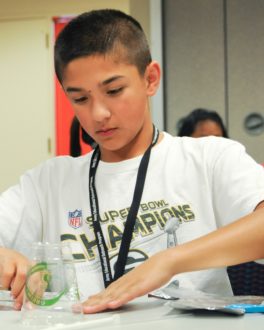May 16, 2017

Dimetrius Simon
NSTA Communications Coordinator for AEOP

When it comes to student-focused science, technology, engineering and math (STEM) projects in eCYBERMISSION, the possibilities are limitless. eCYBERMISSION is a web-based STEM competition free to students in grades six through nine. Teams of three or four students identify community-based problems or inquiries and then construct explanations or design solutions. Students compete for state, regional and national awards.
However, one of the most unique elements of the eCYBERMISSION experience is that student groups take their ideas and solutions outside of the competition and into the real world. As a result, the story of a team’s project can continue long beyond the national awards season—with the potential to create real change in their communities.
One such example occurred during the 2013-14 eCYBERMISSION competition. Team advisor Laura Tenorio and her ninth grade student team, called the Crabyotics, from the rural community of Taos, New Mexico, developed a bio-filter system that successfully removes antibiotic drugs from drinking water and addresses environmental and clean water challenges many communities face after residents flush or pour antibiotic drugs down the drain in their homes. It also helps to prevent the growth of drug-resistant bacteria.
The Crabyotics’ four team members used the resources available in their middle school science lab to research and then create the filter solution they had in mind. With guidance from Tenorio, the students tested their invention, and determined that it not only worked, but was also cost-effective. It even qualified for a patent. The team created a business plan for the development of their bio-filter system community project, and competed in local science fairs and competitions.
But the story didn’t end there. The Crabyotics team won the prestigious STEM-In-Action Grant, a $5,000 grant eCYBERMISSION awards to outstanding projects so that student teams can further implement their STEM projects in their local community.
Years later, one of the Crabyotics team members continues work on the grant with the help of two eCYBERMISSION alumni from other student teams. This new team has added to the success of the Crabyotics’ invention with a second filter using laboratory-honed chitosan (a linear polysaccharide composed of randomly distributed β–linked D-glucosamine and N-acetyl-D-glucosamine) as an absorption media for pharmaceuticals from water sources. They continue to gather more sponsors to support the implementation of their idea through entries in the International Science and Engineering Fair and the Science Talent Search. This year, the students also plan to compete in BioGenius and AEOP’s Junior Science and Humanities Symposium (JSHS).
It’s an incredible story. And yet, there are many more like it. Programs like eCYBERMISSION are remarkable because the benefits they bring to students, parents, teachers and communities are exponential. One mentor inspires four students to explore their passion and talents in STEM, and then those students develop and implement a solution addressing a real problem affecting their own neighbors and community. Years later, that success creates a ripple effect, allowing additional students to build on that solution and embark on their own STEM journey. All the while, each student is better prepared to thrive in school and, one day, pursue an exciting career path, whether in STEM or beyond. Of course, as a side benefit, they are also improving their communities!
Months or years from now, what student STEM projects will we see changing lives? Learn more about enrolling or becoming an advisor for eCYBERMISSION, and visit ecybermission.com to learn more about AEOP STEM-in-Action Grants.
Find a Volunteering Opportunity
Visit our Program Volunteers page for a tool to find the best opportunity for you.
eCYBERMISSION Mini-Grant
The eCYBERMISSION Mini-Grant is intended to support teachers/program leaders as they implement eCYBERMISSION with their teams. Educators (formal and informal) of students in grades 6-9 are encouraged to apply.
